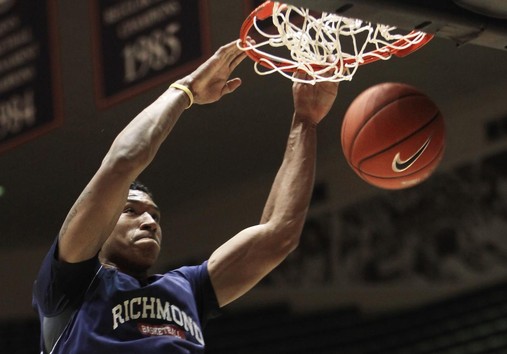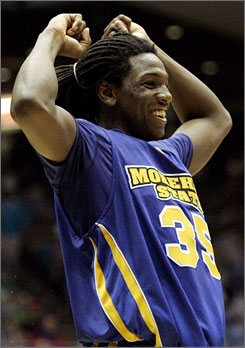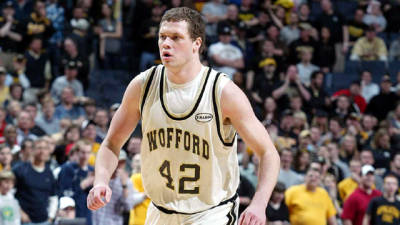The Other 26: Bracket Analysis Part II
Posted by KDoyle on March 17th, 2011Kevin Doyle is an RTC Contributor.
Call it what you want with this seemingly erroneous preamble of the NCAA Tournament known as the “First Four,” but the opening game of this year’s edition of the Dance could not have been much more entertaining. We have already had a clutch shot in the final seconds and an overtime game under our belts. Many people will not even remember that UNC-Asheville and Arkansas-Little Rock even partook in the Tournament, but for a few hours last evening the stage was all theirs. Even if it is merely a play-in game—errr, first round game—this is the NCAA Tournament and keen basketball observers were no doubt glued to their screens and smartphones last night tracking the game.
Just as a refresher in case you missed yesterday’s look into the Other 26 teams in the East and West Regions, I elected to break down the 16 teams by inserting each into one of the four categories: 1) Have a legitimate shot at actually advancing far into the Tournament; 2) Can win a game, but not much more; 3) If their shots are falling and their opponents are not, they have an outside shot; and, 4) We are just happy to be here.
Ability to advance to the second weekend
(8, Southwest) UNLV—After the conclusion of the 2010 Tournament, there is no doubt that a bitter taste was left in UNLV’s mouth. The Runnin’ Rebels lost to Northern Iowa in the final minute and then two nights later, in one of the gutsiest shots in Tournament history, Ali Farokhmanesh drilled a three from the wing to seal the victory over Kansas. UNLV had to painfully watch the remainder of the Tournament and endure the arduous offseason pondering the question: “Why couldn’t that have been us?” Now, UNLV is in a similar situation, as they are in the 8 vs. 9 game again. They are an experienced bunch with Tournament experience under their belts; if they are fortunate enough to get by Illinois, they will ironically play none other than Kansas.
(12, Southwest) Richmond—The Spiders were upset by St. Mary’s last year, and this year they are the ones who will have to be playing spoiler. Richmond has arguably the most dynamic player in the field with 6’10 senior forward Justin Harper. To make a comparison, Harper is the Atlantic 10’s version of Dirk Nowitzki. Although he spends most of his time inside the arc, his ability to step outside and hit a three poses endless match-up problems for opponents. Harper is complemented nicely by his running mate Kevin Anderson. Richmond matches up well against Vanderbilt, but containing John Jenkins—maybe the best shooter in the Tournament—will be a challenge. Expect a variety of match-up and 2-3 zones from Chris Mooney.
(3, Southeast) BYU—It is painfully obvious that the loss of Brandon Davies has detrimentally affected BYU’s play considerably; in the first game after his absence the Cougars were thrashed by New Mexico 82-64 on their home floor. While there is little doubt that Jimmer Fredette is the face of the program and their top player, the country is now officially seeing that there is much more going on in Provo, Utah, that can be attributed to BYU’s success other than simply Fredette. While a deep run no doubt becomes more difficult without the services of Davies, the backcourt of Fredette and Jackson Emery has the ability to carry the Cougars to the second weekend.
(9, Southeast) Old Dominion—ODU presents all of the intangibles to be successful in the Tournament. They have an intelligent and proven coach in Blaine Taylor, a senior-laden team with NCAA experience, and the confidence that they belong here and can win—especially after knocking off Notre Dame as an 11 seed last year. It is more than merely intangibles for ODU though. The Monarchs are quite possibly the best rebounding team in the field, incredibly tough on the defensive end—according to Frank Hassell: “We go 50% man and 50% zone”—and run a deliberate offense that minimizes their opposition’s possessions. Blaine Taylor has created a formula for his team to have success in the NCAA Tournament.
(11, Southeast) Gonzaga—Come on, did you really think the ‘Zags weren’t going to be here? Mark Few’s squad has won nine straight and are clicking on all cylinders. Steven Gray is playing within himself—something he was not doing in the early part of the season—and Robert Sacre has evolved into one of the best big men out West. Playing a St. John’s team that is without D.J. Kennedy will certainly help their chances, and a potential weekend date with BYU becomes a very intriguing game. Without Brandon Davies clogging the paint, Sacre would have ample room to operate down low.
Can win a game
(13, Southwest) Morehead State—Believe it or not, Morehead State has a mismatch against Louisville, and they are not the ones at the disadvantage. Kenneth Faried—the nation’s leading and best rebounder bar none—can exploit a thin Louisville front line. The play of the Cardinal guards will pose endless problems for Morehead State, but if Faried is able to stay out of trouble he may be able to carry the Eagles to a first round win.
(8, Southeast) Butler—We can all admit that the expectations and preseason rankings for Brad Stevens’ club were far too high, but the leadership qualities of Shelvin Mack and Matt Howard cannot be discounted in an NCAA Tournament setting. Mack and Howard, among many others on the team, have been here before and understand what it takes to win. Until this Tournament is over, Butler is still the National Runner-Up—remember that.
(12, Southeast) Utah State—Can the Aggies finally get over that opening round hump? Since 2003, Stew Morrill’s squad has been in the NCAA Tournament five times but has had an early exit in each of the five appearances. With Tai Wesley—one of the nation’s best big men who has flown under the radar playing in the WAC—Utah State will be more than able to hold their old down low against Kansas State. Containing Jacob Pullen will be a challenge, but Tyler Newbold—named to the WAC all-defensive team—should be up to the challenge.
(13, Southeast) Belmont—Ricky Byrd’s Bruins are a popular selection to upset Wisconsin due to their unbelievable balance and impeccable shooting. Although they have played a relatively weak schedule by many accounts, their 30-4 record is impressive nonetheless. It is virtually impossible to key in on one player as Belmont regularly plays 12 guys—although if the opposition selected one player to slow up it would be sophomore guard Ian Clark. Belmont has yet to face a team as physical as Wisconsin, but with how well they spread the floor and move the ball around the perimeter, the Bruins may be able to take the Badgers out of their game.
If things fall their way
(11, Southwest) Virginia Commonwealth—The Rams have a great guard in Joey Rodriguez that can hang with the best, but VCU lacks a dominant big man that can impose his will down low. Shaka Smart’s team ostensibly has a chip on their shoulder as there were many murmurings in the college basketball community that they do not belong in this year’s Tournament, but they proved they should be there with a solid win against a USC team that was trending up. Will this chip be enough motivation to carry them past Georgetown? It may ultimately depend on whether Chris Wright is in uniform, but don’t count them out.
(14, Southwest) St. Peter’s—When analyzing St. Peter’s, it is truly amazing to see just how successful they are at one end of the floor and how weak at the other; one would think the Peacocks play defense against themselves with how poor their offense is. According to Kenpom, St. Peter’s is ranked 277th in offensive efficiency—all that red you see under the offensive makeup is tough to look at—but their defense is nothing short of fabulous: varying shades of green of impressive statistics. St. Peter’s upset Fairfield and Iona in the MAAC Tournament by slowing down the game and minimizing possessions for their opposition. By virtue of a tough defense and grind-it-out offense, they were able to fight their way into the Tournament. This strategy will certainly be implored against Purdue.
(14, Southeast) Wofford—There will be a barrage of threes raining from the sky in Denver on Thursday evening. Wofford is connecting on nearly 41% of their attempts from beyond the arc, while BYU’s Jimmer Fredette and Jackson Emery combine to hit almost six threes a game between them. Wofford’s biggest threat does not lie behind the three-point line however, but rather inside in the form of Noah Dahlman. The Terriers nearly shocked Wisconsin in last year’s Tournament, and will have an outside shot to do the same this year provided their outside shots are falling and Dahlman has a big night.
Thanks for playing, try again next year
(15, Southwest) Akron—The winners of the MAC were the surprise of last year’s Tournament as Ohio knocked off Georgetown as a 14 seed, but Akron will run into a tough Notre Dame team that is playing their best basketball of the season at just the right time; an upset is not in the cards for this MAC team. The Zips are a solid defensive team who do an admirable job of defending beyond the arc, but they have also not seen a team this year that can stroke it quite like the Irish can.
(16, Southwest) Boston University—The task is not all too difficult for Kansas to understand: stop John Holland and you have stopped Boston University. As far as Holland goes is as far as the Terriers will go. In the America East Championship, Stony Brook was able to slow up Holland for the first half, but the senior from the Bronx exploded for 23 second-half points to lead BU past the Seawolves. Kansas simply has too many weapons and will find a way to hinder Holland.
(15, Southeast) UC Santa Barbara—Although Florida’s two seed has been scrutinized by many as being too high, the Gators are simply too strong for the Gauchos. Chandler Parsons and Erving Walker are a great combination that plays off each other nicely and Vernon Macklin is a real bruiser down low. Orlando Johnson is UCSB’s go-to player, but Florida has too much size inside and speed on the perimeter for the Gauchos to compete with.
(16, Southeast) UNC-Asheville—Matt Dickey—for one night at least—was the star of the NCAA Tournament. The junior extended his team’s season by another game as he drilled a three from the corner to send their opening round game against Arkansas-Little Rock into overtime where they went on to win, 81-77. There is not much rest for Asheville as they have a quick turnaround flying from Dayton, Ohio, to Washington D.C., but the adrenaline will unquestionably be at an all-time high for the Bulldogs. It will take a whole lot more than merely adrenaline and confidence for Dicker and Co. to keep it close with Pittsburgh.
Coming early Saturday: a closer look at the Other 26 teams still alive in the East and West Regions and their prospectus in the third round.












































